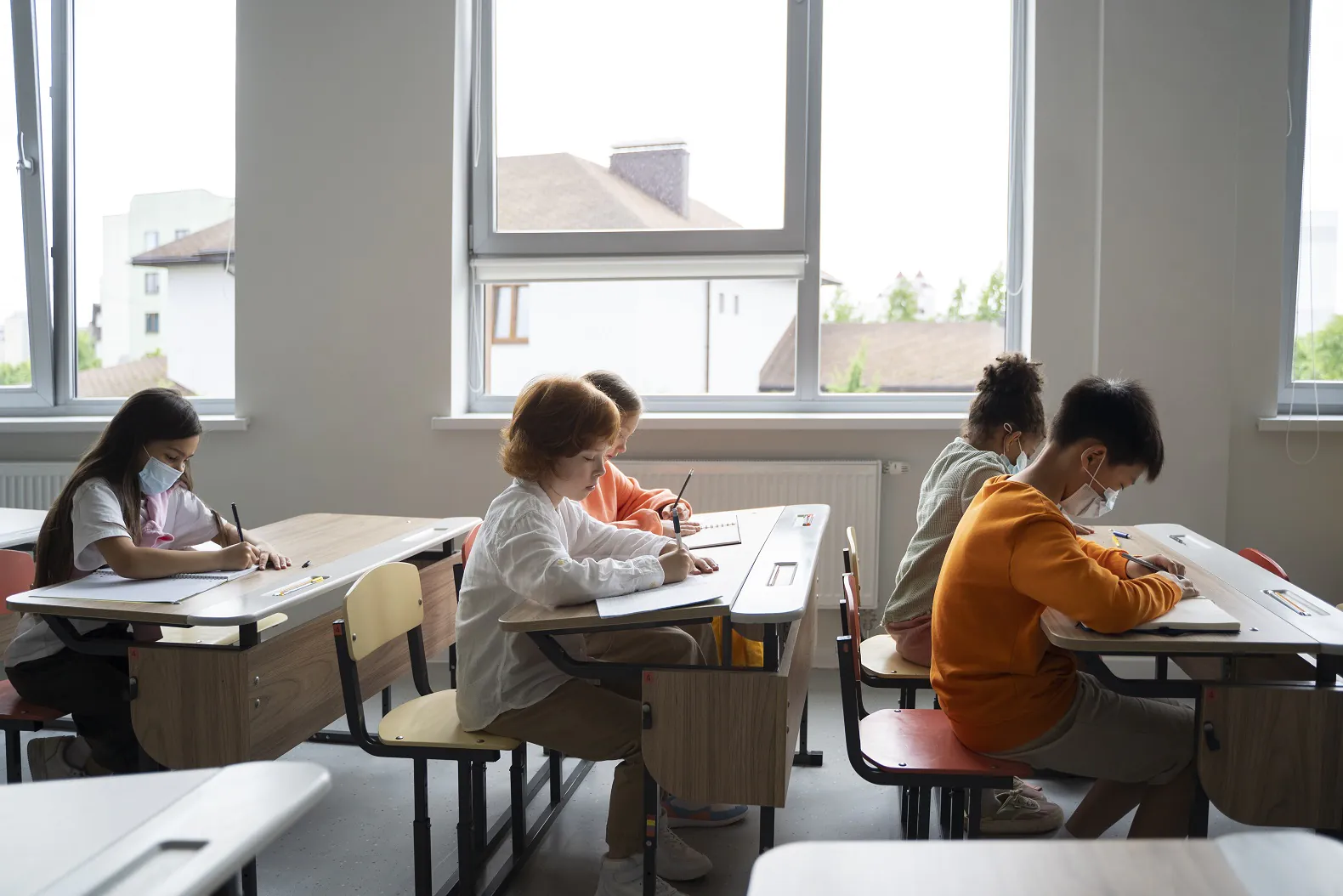Schools are often considered children’s second homes—a home away from home. Since children, teens, and even adults spend a large part of their days in school, it’s easy to adapt to the surroundings and make it their own. This makes it more crucial to make schools and educational establishments as safe and as comfortable as they can be. This includes monitoring school air quality.
While school air quality is one of the last things people think about when keeping school environments safe, it’s an essential part of the surroundings. Air quality at school affects the air students and teachers breathe, how students react to their environment, and how the school brings comfort and shelter to them. This is why school air quality should be monitored.
Are there prior cases of school air poisoning?
In 2022, there have been instances of carbon monoxide poisoning in educational environments in the United States. According to CBS, there were two separate incidents of carbon monoxide leaks at a Missouri school and a Pennsylvania daycare. Six students and two adults were taken to the hospital after the carbon monoxide leak. Meanwhile, at least 16 people from the Pennsylvania daycare were sent to the hospital for their carbon monoxide poisoning. These reported incidents lead to questions about carbon monoxide detectors, particularly the laws that require them in school settings.
These reports also led to other parents recalling previous carbon monoxide leaks in a Virginia daycare facility back in 2020. This resulted in elevated levels of carbon monoxide in the bloodstream, as well as irritability and behavior issues for the following weeks.
A similar situation occurred at a daycare in Nashville, Tennessee, just this year as well. Parents were alerted mid-morning, telling them to pick up their children due to a possible carbon monoxide leak. This incident led to young kids, as young as ten months old, suffering from nausea, breathing issues, and other respiratory problems. Because of this carbon monoxide poisoning, parents worry about certain long-term effects and developmental delays in their children.
Another recent incident this year led to a school evacuation due to carbon monoxide poisoning. KSL News Radio reported that Canyon View Middle School students and teachers were evacuated on January 18th when a strong odor was noticed. More than two dozen people had above-normal carbon monoxide levels, and both teachers and students suffered from headaches, dizziness, and nausea.
A serious carbon monoxide poisoning incident can also have fatal results. Back in December 2023, one student died and three other individuals were injured due to possible carbon monoxide poisoning at a college campus apartment. Carbon monoxide alarms were first reported in the housing area of Evergreen State College. This prompted the local fire department to respond and conduct carbon monoxide testing in the impacted areas.
Of course, the arrival of COVID-19 in 2020 also revealed how careless school officials can be when it comes to indoor school air quality. Some weren't prepared to provide clean, virus-free air to their students, teachers, and staff. In fact, according to the Government Accountability Office (GAO) in June 2020, 41% of surveyed school districts needed HVAC system upgrades or replacements in more than half of their schools to provide clean air for their occupants.
The COVID-19 virus, as well as other easily transmitted airborne diseases like influenza and the common cold, can cause outbreaks among students and staff. Several students can easily catch diseases and pass them on to others without knowing. This can lead to higher absence rates, which can disrupt learning, and even prompt temporary school or classroom closures in extreme cases.
While the Centers for Disease Control and Prevention (CDC) survey of U.S. school districts reported several indoor air quality improvements in late 2022, there is still a long way to go. Schools can go further for the safety of their students, teachers, and staff. Various learning environments and educational institutions need to implement certain practices that will help monitor and maintain good air quality and ventilation for students and staff alike.
What are the most common school air pollutants?
School air, just like in any other environment, can be easily tainted by various pollutants. And it’s a little more difficult when they can’t exactly be seen with the naked eye. In a school environment where most of its inhabitants are little children, teens, and young adults, the administration needs to be vigilant.
The most common air pollutants found in schools include:
- Volatile Organic Compounds (VOCs): Volatile organic compounds are emitted from various sources, such as paints, solvents, cleaning agents, and building materials. VOCs can cause respiratory irritation and other health issues, especially when prolonged exposure occurs.
- Particulate Matter (PM): PM refers to tiny particles (solid or liquid) suspended in the air. They can come from sources like dust, pollen, mold spores, and combustion processes. Particular matters can irritate the eyes, nose, and throat and can aggravate any existing respiratory conditions among people.
- Carbon Dioxide (CO2): CO2 levels can rise in poorly ventilated spaces due to human respiration. High levels of CO2 can lead to drowsiness, headaches, and impaired cognitive function. In a school, this can impact students' ability to concentrate and learn from their classes.
- Carbon Monoxide (CO): CO is a colorless, odorless gas produced by combustion processes such as gas heaters, stoves, and vehicles. Exposure to high levels of CO can be dangerous, as it can cause headaches, dizziness, and even carbon monoxide poisoning in extreme cases.
- Formaldehyde: This is a type of VOC commonly found in building materials, furniture, and insulation. Prolonged exposure to formaldehyde can cause respiratory issues and may even increase the risk of cancer for people exposed to it.
- Mold and Mildew: Damp indoor environments can promote the growth of mold and mildew, which can release spores and volatile organic compounds. Mold exposure can trigger allergies and respiratory problems in people with vulnerable immune systems.
- Nitrogen Dioxide (NO2): Nitrogen dioxide is a byproduct of combustion processes, particularly from vehicles and gas appliances. Exposure to NO2 can irritate the respiratory system and exacerbate asthma symptoms.
- Ozone (O3): Ozone can form indoors through chemical reactions involving VOCs and other pollutants. High levels of ozone can cause respiratory irritation and worsen asthma symptoms, much like nitrogen dioxide.
These are just some of the common examples of pollutants in school air. They can cause discomfort, irritation, further respiratory complications, and even poisoning due to prolonged exposure.
Effects of low-quality air in classrooms
Low-quality school air will negatively affect not only students but the various school staff as well. Everyone in the vicinity can be affected and put in harm’s way if school officials, administrators, and custodians don’t take into account the quality of air in their environment.
Here are some of the effects of low-quality air in classrooms:
Reduced cognitive function and productivity
- Attention and Concentration: Poor indoor air quality can impair students' ability to focus and sustain attention during lessons, leading to decreased academic performance.
- Memory and Learning: Exposure to air pollutants can interfere with memory consolidation and learning processes, making it harder for students to retain information and perform well on tasks requiring cognitive processing.
- Energy and productivity: Bad air quality and ventilation can cause enough irritation and confusion, which can negatively affect student’s energy and productivity. They might not have the motivation to participate in team exercises or the energy to complete certain tasks and activities.
Fatigue and discomfort
- Elevated CO2 Levels: High levels of carbon dioxide (CO2) in poorly ventilated classrooms can lead to feelings of drowsiness, fatigue, and lethargy among students and teachers. This might hinder focus and concentration among students.
- Headaches and Discomfort: Exposure to indoor pollutants can cause headaches, eye irritation, and general discomfort among students and staff. This makes it challenging for individuals to remain alert and engaged in learning activities.
Respiratory issues and allergic conditions
- Asthma Exacerbation: Asthmatic students and teachers are particularly vulnerable to the effects of various indoor air pollutants. They can trigger asthma symptoms such as wheezing, coughing, and shortness of breath. This can also lead to specific asthma conditions worsening every time.
- Allergic Reactions: Indoor allergens such as dust mites, pollen, and mold can induce allergic reactions in susceptible individuals, like young children and those with sensitive skin or respiratory conditions. These can cause symptoms like nasal congestion, sneezing, and itchy eyes.
Increased absenteeism
- Illness: Poor indoor air quality can increase the spread of respiratory infections and illnesses among children. This can further contribute to absenteeism in schools.
- Respiratory Issues: Air pollutants like allergens, mold spores, and volatile organic compounds (VOCs) can trigger asthma attacks and respiratory conditions, resulting in higher rates of absenteeism among students and teachers.
Impact on teacher performance
- Job Dissatisfaction: Poor indoor air quality can negatively impact teachers' job satisfaction and overall well-being. This might lead to increased stress levels and decreased morale. It might also lead to reduced employee retention for the learning institution.
- Less Productivity: Teachers may also experience reduced productivity and effectiveness in delivering lessons and managing classroom behavior in environments with poor air quality.
Behavioral changes
- Irritability and Restlessness: Indoor air pollutants may affect the mood and behavior of the occupants. This leads to increased irritability, restlessness, and agitation among students and even teachers.
- Difficulty Concentrating: Children exposed to poor indoor air quality may experience difficulty concentrating. This makes it harder for them to follow instructions or participate in classroom activities and events.
Negative impact on health
- Respiratory Diseases: Prolonged exposure to indoor air pollutants may increase the risk of developing respiratory diseases such as chronic bronchitis, emphysema, and pneumonia.
- Cardiovascular Problems: Certain indoor pollutants, including fine particulate matter (PM2.5), can contribute to cardiovascular issues such as hypertension, heart disease, and stroke. Fine particles like PM2.5 are even more dangerous as they are extremely small and can be inhaled without the person knowing.
- Poisoning: In some cases, poor school air quality might lead to serious health impacts, such as carbon monoxide poisoning and nitrogen dioxide poisoning.
Long-term health risks
- Cancer Risk: Some indoor air pollutants, such as formaldehyde and certain volatile organic compounds (VOCs), are classified as carcinogens. Carcinogens can increase the risk of developing cancer, especially with prolonged exposure.
- Developmental Effects: Exposure to certain indoor pollutants during critical periods of development may have long-term effects on children's health, cognitive function, and behavior. Young children learning in their formative years.
Ways to prevent school air poisoning
Preventing school air poisoning or poor air quality involves a combination of proactive measures and practices aimed at reducing indoor air pollutants and improving ventilation. It’s also important that local government, school officials, students, and parents all work together to maintain a safe space with breathable air for children and staff.
Here are some effective strategies:
Regular Maintenance of HVAC Systems
Schools should ensure that heating, ventilation, and air conditioning (HVAC) systems are properly maintained, cleaned, and serviced regularly. This will prevent the buildup of dust, mold, and other contaminants.
Effective Ventilation
Increasing outdoor air ventilation rates also works. This can dilute indoor pollutants and improve indoor school air quality. Consider using natural ventilation methods such as opening windows and doors when weather conditions permit. Use mechanical ventilation systems with high-efficiency particulate air (HEPA) filters or other air filtration technologies to remove airborne pollutants effectively.
Education and Awareness
Educate students, teachers, and school staff about the importance of indoor air quality. Highlight how they can contribute to maintaining a healthy indoor environment through proper ventilation, cleaning practices, and source control.
Source Control
Identify and eliminate or minimize sources of indoor air pollutants such as VOCs, formaldehyde, and mold. Choose low-emission building materials, furniture, and cleaning products whenever possible. Implement policies to restrict smoking and prohibit the use of certain products that emit harmful pollutants indoors.
Regular Cleaning and Maintenance
Implement a comprehensive cleaning program to remove dust, dirt, and other contaminants from surfaces, floors, carpets, upholstery, heaters, ventilation, and other appliances. Pay special attention to areas prone to mold growth, such as bathrooms, kitchens, and damp or poorly ventilated spaces.
Proper Storage of Chemicals and Hazardous Materials
It’s also important for schools to store chemicals, cleaning agents, and other hazardous materials in designated areas with adequate ventilation and proper containment. Proper storage can prevent the release of harmful fumes. Following safety guidelines and protocols for handling and disposing of hazardous substances can also minimize the risk of exposure.
Promotion of Good Hygiene Practices
Encourage students, teachers, and staff to practice good hygiene habits. This includes regular handwashing, covering coughs and sneezes, and disposing of trash properly. These practices help reduce the quick spread of respiratory infections and illnesses among students and staff.
Indoor Plants
Introduce indoor plants in classrooms, hallways, and other shared facilities for their air-purifying properties. Indoor plants such as spider plants, peace lilies, and snake plants can help reduce carbon dioxide in the air and improve air quality naturally. Several studies have also shown that houseplants can remove formaldehyde, benzene, and other toxins that plague typical indoor air.
Air Quality Monitoring
And of course, schools can also implement a regular monitoring program to assess indoor air quality. Check for parameters such as CO2 levels, humidity, temperature, and the presence of specific pollutants. Use air quality monitors and sensors to detect changes in air quality and identify potential issues before they escalate. Air quality monitoring can be a proactive and vigilant method of keeping school air safe and avoiding serious health-related incidents.
Why use SOLUM Roommate to monitor classroom air quality
Air quality monitoring can be quite beneficial, especially when alerting occupants to anything harmful in the air. In schools, air quality monitors can help determine and identify which specific toxins are pollutants in an area, give reports, and alert users to any immediate action.
Fortunately, SOLUM Group offers a smart indoor air quality monitor ideal for classrooms and learning environments. Known as the SOLUM Roommate, this smart air monitor can analyze the air and detect pollutants within any indoor environment while also managing temperature, cleanliness, and moisture content.
Individual students, teachers, and school administrators can use SOLUM Roommate to monitor the school air quality at different parts of the day. It only needs to be plugged into an outlet, and it can immediately start collecting data on the surroundings. The mobile app and LED indicators that come with SOLUM Roommate can indicate the overall air quality in a classroom or school facility. It’s also a portable air quality monitor, which means it can analyze and monitor various enclosed spaces and can easily be carried by students or teachers.
SOLUM Roommate is equipped with various features that can be used inside a classroom, including:
- Air quality monitoring and measuring
- Built-in motion detector
- LED light indicators
- Temperature monitor
- Humidity Level monitor
- Discomfort Index monitor
- Downloadable SOLUM Roommate app
When it comes to school air quality, it’s better to be vigilant, proactive, and preventative. Daily air quality monitoring can help protect students and staff and even save lives.
Do you think you need a smart air quality monitor like SOLUM Roommate? Contact SOLUM Group experts now and find out how it can contribute to cleaner and safer air.











